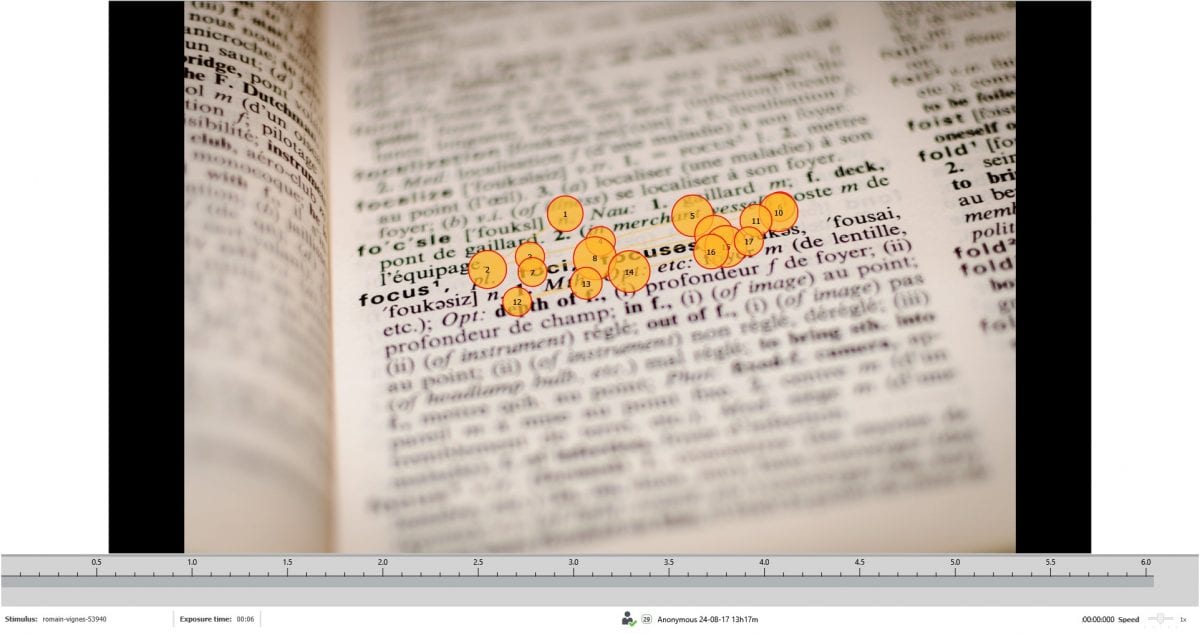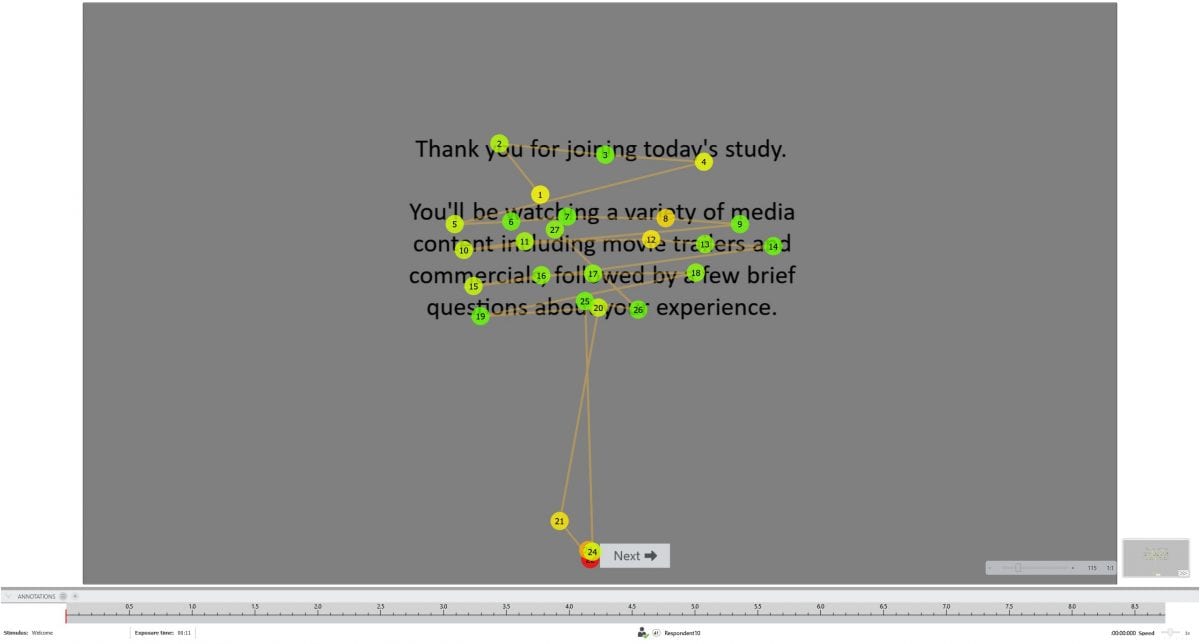You’re reading these words. If an eye tracker was to follow how you were reading, it could provide information about how long you spent looking at the text, which words you skipped, and which words you dwelled on.
As long as scientists have used eye trackers, they’ve also been studying how the eyes help us read – although not necessarily together. Beginning in 1879, Emile Javal, a French Opthamologist [1], began to study how our eyes allow us to read. This was done through manual observation – not with an eye tracker – but he managed to elucidate many of the behavioral patterns that we think of as common knowledge now in eye movement research, such as saccades and fixations.
While there are four main types of eye movements (pursuit, vergence, vestibular, and saccadic), one is particularly relevant and valuable when understanding reading: saccadic.
What are saccades?
Whenever we visually explore an environment, search for an object, or of course read, we continually make rapid eye movements called saccades [2]. These saccades typically last from 20 ms to 200 ms (although saccades that are on the quicker end of this scale are known as express saccades [3, 4]).
Between these saccades, our eyes remain still for around 200-300 ms – this known as a fixation [3] (“still” is a bit of a relative term here – our eyes often continue to move around as a result of optokinetic nystagmus, which aids visual processing in the brain [4]).
The reason we rely so heavily on saccades for reading is due to our limited visual acuity – as detailed visual information is only available for a small portion of what we look at, it means that we can only reliably perceive what we look at directly. The center of our visual field is highly accurate, but that accuracy quickly declines outside of that center. Look at this word, and try and read what’s around it – you can quite literally see how difficult it can get.
By rapidly moving our eyes from one fixation point to another with saccades, we can just as rapidly see – and therefore process – the information conveyed by text.

What else do we know about how we read?
The average saccade size is 7-9 letter spaces, although this will of course depend on the size of the text, and the font type. Unsurprisingly, this number decreases as the text becomes more difficult to read [2].
For English speakers / readers, the direction of reading doesn’t purely follow from left-to-right with saccades, but also involves right-to-left eye movements approximately 15-25% of the time [5]. The proportion of right-to-left eye saccades increases if the text requires a lot of mental effort (i.e., as cognitive load increases) [2, 6].
To complicate matters further, the first fixation that we make in a sentence (the word “To” for this sentence) tends to be longer than all of the subsequent fixations [7], and the final fixation is the shortest of all [8].
While these may appear to just be fun facts to know about reading, understanding what is normal about how we read can also help us when reading is, or becomes, abnormal.

Why understanding how we read matters
Abnormal eye movements are found in a range of diseases and disorders. While negatively-impacted eye movements might not be particularly surprising to find for a disease that impacts the eye directly, such as glaucoma [9], the fact that it impacts reading provides new insight into how it also affects perceptual processes.
Beyond diseases or disorders that affect the eye directly, abnormal reading patterns have also been found in individuals with dyslexia. These abnormal reading patterns have also been found to have predictive power, opening up the possibility of an objective, non-invasive diagnosis tool [10].
Reading has additionally been found to be impacted in neurodegenerative diseases, such as Alzheimer’s disease [11, 12]. Analysis of reading patterns could present a new mechanism by which to provide an early diagnosis, or indicator, of the disease [13]. This is particularly important for Alzheimer’s disease, as early intervention is currently the only known way to improve the relative progression of the disease [14, 15].
Thus, eye tracking studies of reading can be a particularly robust source of insights into disease and disorders. The utility of eye tracking for measuring reading, however, is not restricted to the study of disease or diagnosis. Advertising studies can benefit from knowing whether or not an individual actually read text, or simply glanced at it – being able to follow reading behavior offers that insight. A similar principle applies to UX design: Knowing what information is actually processed can help researchers improve design, as it’s possible to see what is actually read and what isn’t.

What you need to study reading
Research of reading is an exciting field, and the ability to dissect in detail the ways in which people view text can be important not only for psychophysiological studies, but also for fields such as neuromarketing, UX, and human-computer interaction.
However, here comes the caveat – any study that aims to explore the detailed mechanics of reading needs to use an eye tracker with a sampling rate that is high enough to capture saccades. Because saccades can be completed in as little as 20 ms, this requires a sampling rate of at least 100 Hz (you need a sampling rate which is double the rate of the phenomena in order to reliably capture it). If you want to go deeper and measure saccade durations, then an even higher sampling rate will be required – an absolute minimum of 200 Hz is advised [16].
There are various eye trackers that are up to the challenge – the following are a list of eye trackers that not only have sampling rates high enough to detect reading and / or saccades (divided below), but can also be used with iMotions.
>100 Hz
- Smart Eye AI-X (60Hz)
- Smart Eye Aurora (60/120Hz)
- EyeTech VT3 mini (120 Hz)
- Gazepoint GP3 HD (150 Hz)
>200 Hz

References
- Javal, É. (1905). Physiologie de la lecture et de l’écriture. Paris: Félix Alcan
- Rayner K. (1998). Eye movements in reading and information processing: 20 years of research. Psychol. Bull. 124 372–422. 10.1037/0033-2909.124.3.372
- Fischer, B.; Ramsperger, E. (1984). Human express saccades: Extremely short reaction times of goal directed eye movements. Experimental Brain Research. 57.
- Kingstone A, Klein RM. (1993). What are human express saccades? Perception & Psychophysics. 54(2):260–73.
- Booth RW, Weger UW. (2013). The function of regressions in reading: backward eye movements allow rereading. Mem Cognit. 41: 82–97.
- Inhoff, A. W., Greenberg, S. N., Solomon, M., & Wang, C.-A. (2009). Word integration and regression programming during reading: A test of the E-Z Reader 10 model. Journal of Experimental Psychology. Human Perception and Performance, 35, 1571–1584.
- Heller, D. (1982). Eye movements in reading. In R. Groner & P. Fraisse (Eds.), Cognition and eye movements (pp. 139-154). Amsterdam: North Holland.
- Rayner, K. (1978). Eye movements in reading and information processing. Psychological Bulletin, 85, 618-660.
- Cerulli A, Cesareo M, Ciuffoletti E, et al. (2014). Evaluation of eye movements pattern during reading process in patients with glaucoma: a microperimeter study. Eur J Ophthalmol 24:358–363.
- Benfatto MN, Seimyr GO, Ygge J, Pansell T, Rydberg A, Jacobson C. (2016). Screening for dyslexia using eye tracking during reading. PloS One. 11(12):e0165508
- Fernandez G, Schumacher M, Castro L, et al. (2015). Patients with mild Alzheimer’s disease produced shorter outgoing saccades when reading sentences. Psychiatry Res, 229:470–478. 29.
- Fernandez G, Laubrock J, Mandolesi P, et al. (2014). Registering eye movements during reading in Alzheimer’s disease: difficulties in predicting upcoming words. J Clin Exp Neuropsychol, 36:302–316.
- Fernandez G, Castro LR, Schumacher M, Agamennoni OE. (2015). Diagnosis of mild Alzheimer disease through the analysis of eye movements during reading. J Integr Neurosci, 14:121–133. 30.
- Rodakowski J., Saghafi E., Butters M. A., Skidmore E. R. (2015). Non-pharmacological interventions for adults with mild cognitive impairment and early stage dementia: an updated scoping review. Mol. Aspects Med. 43 38–53. 10.1016/j.mam.2015.06.003
- Claxton A., Baker L. D., Hanson A., Trittschuh E. H. (2015). Long-acting intranasal insulin detemir improves cognition for adults with mild cognitive impairment or early-stage Alzheimer’s disease dementia. J. Alzheimers Dis. 44 897–906. 10.3233/JAD-141791
- Kenneth Holmqvist, Marcus Nyström, Richard Andersson, Richard Dewhurst, Halszka Jarodzka, Joost van de Weijer (2011). Eye Tracking: A comprehensive guide to methods and measures. OUP Oxford, UK.











